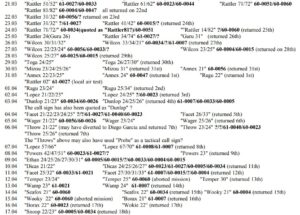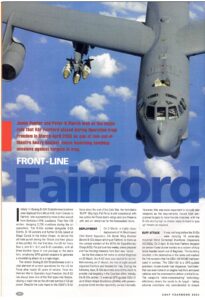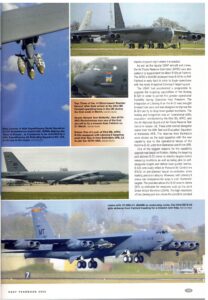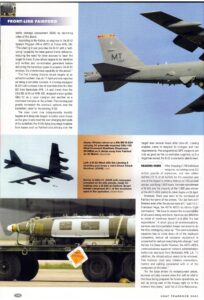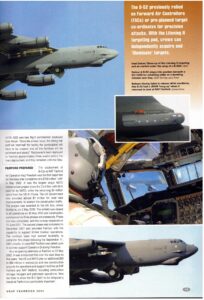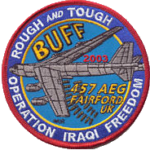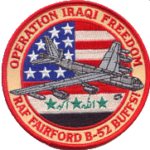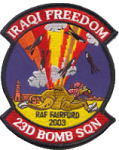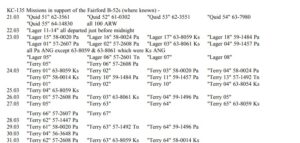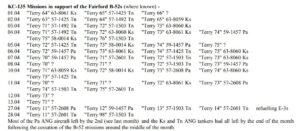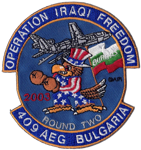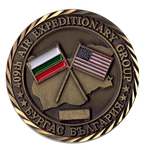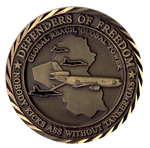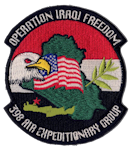OP IRAQI FREEDOM
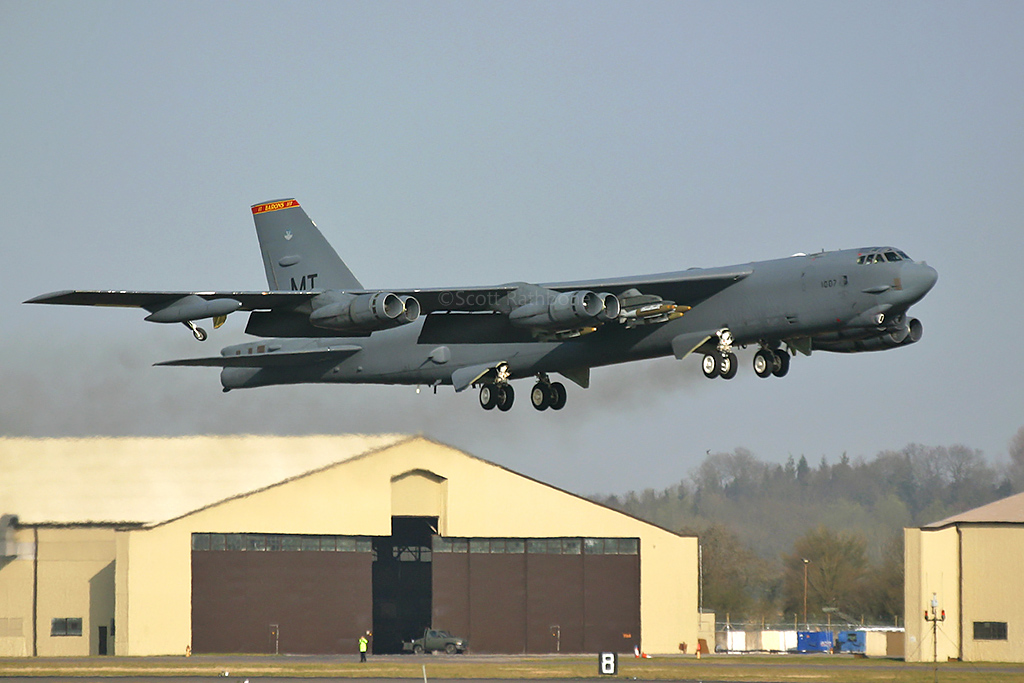
3rd March 2003 – UK Secretary of State for Defence Geoff Hoon announced in the House of Commons that permission had been granted for the USAF to base 14 B-52 Bombers at RAF Fairford in support of of the impending war in Iraq.
March 3rd/4th saw the arrival at Fairford of 14 B-52H’s from 5th BW at Minot AFB North Dakota to form the 457 Air Expeditionary Group.
Logs from ‘Military Aviation Review’ April & May 2003
03.3 5 BW 23 BS B-52Hs “MT” 61-0027 60-0033 60-0044 60-0060 60-0047 60-0051 60-0004 61-0007 arrived in order as “Rippr 11-18” all carried red/yellow fin marks and “MT” code except 61-0027 which was unmarked
04.3 60-0023 61-0040 60-0015 60-0026 60-0056 60-0034 arrived in order as “Rippr 21-26” all wore the red/yellow fin markings and “MT” code of the 23 BS, 60-0023 was marked up as the 23 BS CO’s aircraft
Operational flights
(According to ‘B-52H Stratofortress Key Publishing’ the 457th AEG at Fairford launched eight B-52Hs in the first wave of attacks. The lead jet, flown by Lieutenant Colonel Bussian, had to abort because of an avionics problem, and the lead position was instead taken by a B-52H (60-0060 Iron Butterfly) commanded by Captain Jason D. Horton)
Training Flights
13.3 “Choir 11/12” 60-0034 60-0056
14.3 “Ranty 11/12” 60-0034 & 60-0056
15.3 “Tenor 11/12” 60-0056 60-0034
17.3 “Prim 11/12” 60-0034 60-0056
18.3 “Choos 11/12” 60-0034 60-0056
Aircraft changes during April –
02.4 60-0005/MT B-52H 5 BW CO arrived as “Rippr11”
04.4 60-0047/MT B-52H 5 BW returned to the USA as “Rippr11”
61-0021/BD & 61-0008/BD B-52H 93 BS arrived as “Scalp 93/94”
09.04 60-0051/MT B-52H 5 BW departed as “Edge 69”
10.04 60-0026/MT B-52H 5 BW departed as “Chill 69
Departures
17.04 “Ripper 10”
23.04 “Ripper 81/82” to Diego Garcia 61-0008/BD 61-0021/BD (serial number order not known)
24.04 “Victory 11” “Victory 12” “Victory 21” “Victory 22” “Victory 31” 60-0060 “Victory 32” 60-0034 “Victory 41” 61-0007 “Victory 42” “Victory 51” “Victory 52”
The large Civilian and Military security force was re-enforced by two HH-60G’s, which took it in turns to come from Mildenhall to carry out fence patrols at Fairford and Welford. Helicopters involved were 89-26206/IS and 89-26212/IS, both on TDY from the 56RQS in Keflavik.
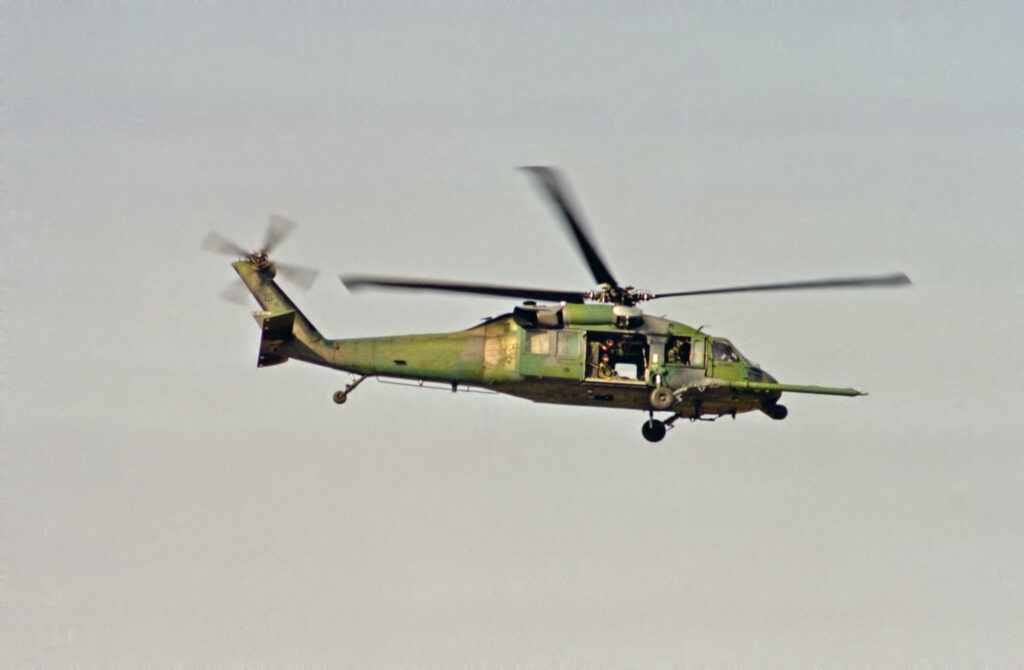
There is a great write up on ‘Front-Line Fairford’ in the 2003 United States Air Force Yearbook
457th Air Expeditionary Group
Col Daniel J. Charchian
The 457th Air Expeditionary Group was activated as a combat unit as part of the Global War on Terrorism, to support Operation Iraqi Freedom. It is known that the group supported B-52 Stratofortresses operations, using B-52Hs attached from the 23d Bomb Squadron, Minot AFB, North Dakota and USAF Reserve 917th Wing, Barksdale AFB, Louisiana. The B-52s operated from a “forward deployed location”, which was RAF Fairford, England. The unit inactivated sometime after Operation Iraqi Freedom ended active combat operations
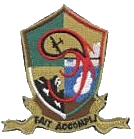
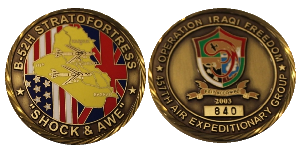
B-52H Shock & Awe
5th Expeditionary Operations Support
The 5 EOSS was not an official organization, but a convenient way to group the deployed functions that normally fell under a traditional Operations Support Squadron at home station. It contained mission planning, intelligence, weather and a communications function, all necessary to conduct deployed operations.
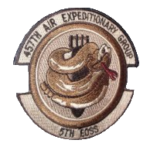
16th Air Expeditionary Task Force
(Command Unit for the 457th AEG)
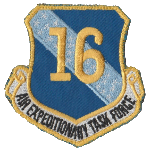
Italian Made Patch
23d Expeditionary Bomb Squadron
Lt Col Robert F. Bussian
The 457th Air Expeditionary Group would have been created first, with the 23d Expeditionary Bomb Squadron following and assigned to the AEG. The 23 EBS remained a subordinate unit to the 457 AEG through the duration of the deployment
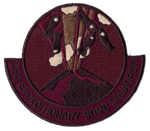
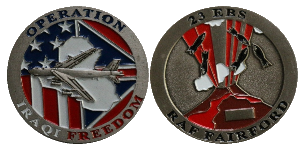
These 3 patches were not worn by USAF crews and likely produced after OP Iraqi Freedom
European Air Refueling
On the outward bound flights from RAF Fairford the B-52s were refueled by tankers from RAF Mildenhall. On the return leg the B-52s were refueled by KC-10s flying out of Burgas, Bulgaria using “Toric” call signs.
RAF Mildenhall hosted KC-135Es from 117th ARS Kansas ANG, 171st ARW Pennsylvania ANG and 151st ARS Tennessee ANG.
The following logs came from ‘Military Aviation Review’ April & May 2003
401st Expeditionary Operations Group
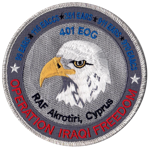
Additional KC-135 tanker Operations for Operation Iraqi Freedom were conducted from RAF Akrotiri.
The 401st EOG located at RAF Akrotiri, Cyprus, comprised of –
– 99 EARS (Robins)
– 116 EACCS (E-8 JSTARS)
– 351 EARS (RAF Mildenhall)
– 911 EARS (Grand Forks)
– 970 EAACS (E-3 Sentry)
409th Air Expeditionary Group
KC-10A Operations were conducted from Burgas Airport, Bulgaria, as part of the 409th Air Expeditionary Group.
398th Air Expeditionary Group
Located at Souda Bay, Greece. Comprised of RC-135 (55 RW), NKC-135E (412 Test Wing), KC-135, EP-3E (VQ-2)
Other European Air Refueling bases include – Lajes (KC-135), Rota (KC-135 & KC-10) and Incirlik (KC-135)
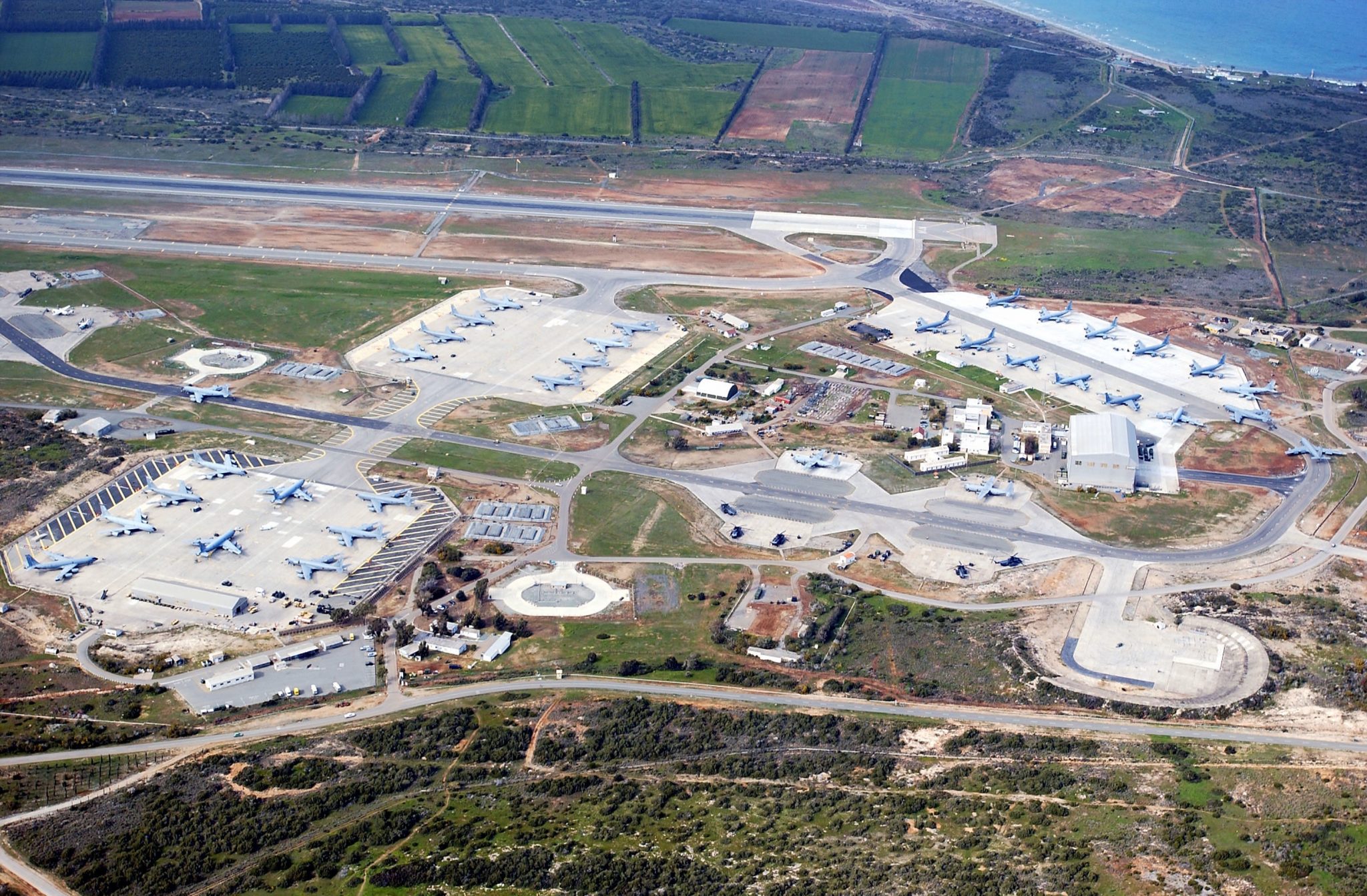
Source www.markhasara.com
Air Force forward-operating base scales down after operation
Released: April 25, 2003
By Tech. Sgt. Jason Tudor
457th Air Expeditionary Group Public Affairs
Royal Air Force Fairford, England (USAFENS) – From February to April, Fairford became an anonymous “forward-deployed location” for B-52s that flew 120 missions over Iraq.
By most, it is called a “turnkey” operation. The DOD turns a figurative “key,” and a 9,997-foot runway, more than $90 million in renovations and a multitude of resources come to life. All of it sat idle since Operation Allied Force four years before, managed by the 424th Air Base Squadron.
“I liked to call this place ‘Mayberry, RAF,'” said Tech. Sgt. Jim Calbert, the air base squadron’s unit training manager who arrived just as Allied Force ended. “It’s so close and everybody knows everybody else. It was also very, very quiet.”
Less than three weeks later, the place teemed with more than 1,200 airmen from bases around the globe and enough bomber firepower to obliterate 100 regimes.
Lodging filled 63 rooms, some living four to a room. Contingency dormitories held 20 to a bay. Trailers slept 12 to a unit. Some slept in a hangar on cots and few complained about their digs given other places they could have landed.
Meanwhile, blue buses ran 24-hours, keeping the workers moving. The dining hall served an average of 1,916 meals every day. The base exchange extended its hours and hundreds of new arrivals could be seen walking at all hours wearing reflective belts.
A big part of the phenomenon that transformed Fairford from peacetime stronghold into a wartime bomber group was money, and Tech. Sgt. Mike Hogan was the shylock with the credit card.
As a contracting specialist, Hogan and one other NCO bought everything needed from a $600,000 closed-circuit television system to $7 videotapes. When he added up all 535 receipts, Hogan had spent more than $3.5 million during the contingency.
“When everything is a priority you have to prioritize the priorities,” Hogan said. “We had many masters who were hard to please and meet their mission requirements.”
As Hogan paid the bills, the base itself was under siege. Protesters lined up early and often. Some dared to climb the fence, barge through the front gates and violate British law to get in. Led most notably by a group called the Gloucestershire Weapons Inspectors — which had neither weapons nor official inspectors of any kind — they charged into the breach.
“We aim to interfere with the smooth running of the base by blocking the base entrance,” said protestor Ann Pettit to a local newspaper.
The police forces swelled to more than 300. Local, military and a contingent of Nepalese Gurkhas lined the fences. A Blackhawk helicopter equipped with secret sensors and detection equipment kept watch from above. Other less detectible and more secret measures also pulsed on. Some had nicknamed the place “Fortress Fairford.”
Senior Airman André May, one of the young cops assigned to watch the fenceline, summed it up more directly.
“We’re determined to not allow anyone who hops the fence anywhere near our aircraft,” May said. “If someone does get through, we’re all over them.”
At the height of the protest hysteria Feb. 21, security outnumbered protesters by nearly two to one. More than 20,000 anti-war demonstrators were expected that day. Just 600 showed. About 1,100 guardians behind a locked gate waited as much of the protest energy flowed to London, instead.
Eight bombers streaking off on the early morning hours of March 21 signaled the moment Fairford entered the war. During 33 days of round-the-clock operations, more than 2,700 bombs and cruise missiles streamed in from local storehouses and got loaded onto 457th Air Expeditionary Group B-52 bomb racks for delivery somewhere over Iraq.
None of it went unnoticed by the world. From the beginning, a half-dozen television crews from Fox News, the Associated Press and others broadcast live takeoffs and landings. Local newspapers kept regular tabs on activities, including the more than 50 protestors arrested trying to get in.
At its apex for Operation Iraqi Freedom, Fairford closely mirrored what it had done for Operation Allied Force four years before. In each case, B-52s were part of the initial strike package, more than 120 missions were flown, and more than 1,000 airmen called Fairford home.
By April 17, however, the Marines rolled into Baghdad and ground forces had taken most of the country. Fairford bombers will still flew one or two missions each day, but they were coming home with their bomb racks full.
Less sorties meant less work. Less work meant more interest in the one question simmering on everyone’s lips: when are we going home?
The answer came April 23 when the 457th Air Expeditionary Group’s redeployment orders got signed. Three days later, following a visit by a Congressional delegation, the bombers flew home. In about five days time, Fairford contracted from more than 1,000 to less than 200 people.
When someone crunched the numbers, Fairford bombers flew more than 1,600 flying hours catapulting more than 3.2 million pounds of munitions and 9 million leaflets into battle. It served more than 116,000 meals to the troops, deterred thousands of protestors and fielded in combat a never-before-used on a B-52 weapon system called the Litening Pod.
As the first high rollers left Fairford, Mission Support Group Commander Col. Larry Johnson couldn’t say enough about the success of Fairford during war.
“Everyone can give themselves a pat on the back for this effort. It was Herculean — monumental. I was proud to be associated with it,” Johnson said during a staff meeting.
Meanwhile, people like services chief Michael Hertlein said the brunt of the work was yet to be done. His team still had to close-up all the contingency dorms, file all the paperwork and get ready for the next battle — whenever it may come.
“I would then like to think it will be quite enough to give my folks some well earned time off and, of course, take some myself — but I doubt it. This is the busiest little base I have ever worked at,” Hertlein said.
Calbert reflected on how he and his Fairford teammates handled the sudden rush of military celebrity.
“That’s why our squadron patch motto says ‘Always Ready,'” he said, tugging at the left pocket of his battle-dress uniform blouse. “That’s why we’re here.”
— USAFENS —

